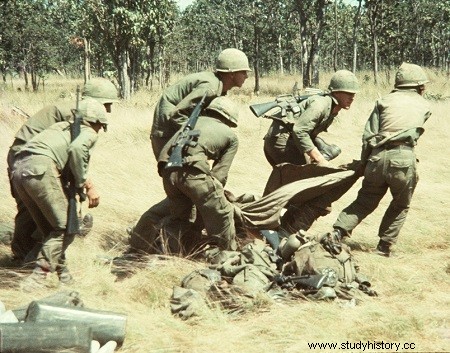
Brown, the commander of Bde., flew over the scene of the fight , and Moore told him that he was dealing with about 600 North Vietnamese who would no doubt soon be reinforced. He asked for a company. supplement, a request which Brown had anticipated, also Co. B of 2nd Bn. from 7 of Cav. she stood ready to intervene as soon as the situation improved in the landing zone. Two aircraft had been so damaged during the last trip that they could no longer take off; their wreckage remained on the edge of the landing area while their crews left with other helicopters. The best support Brown could provide at this time was to land the 2nd Bn. of the 5th of Cav. in the VICTOR landing zone, 3 km southeast of X-RAY. This battalion had to dug in for the night and push the next morning to Moore's command post.
The chain of command
Towards the middle of the afternoon, Moore noticed that, following the action of the Companies. This D, the enemy fire which swept the landing zone diminished in intensity, consequently, as quickly as possible, it made pose the last three apparatuses of the Company. C, the Sn. of reconnaissance, a team of pathfinders as well as the second in command and the sergeant major of the Cie. D. On the line of contact, the Companies. A and B had withdrawn slightly for the purpose of coordination while the Cies. -C and D only held their ground with heavy fire and requested artillery support.
The enemy was only a few meters from the Sn. isolated, so close that the men could not raise their arms to dig holes. The chief of Sn., his sergeant of Sn. and six men had been killed. Sergeant Savage, the highest remaining officer, and his orderly had shown remarkable leadership skills in handling the 7 uninjured men and the 12 wounded, many of whom continued to fight. The 7th of Cav. being airmobile, the men could carry a heavier load, so it was regulation for each man to carry more than 300 cartridges for M-16 rifle, at least two defensive grenades, two canisters of water and a reserve food ration. Each grenadier had about 30 projectiles and each gunner at least 800 rounds for his M-60. Most men had an even higher endowment. Unless overwhelmed by numbers, Sn. isolated louse will therefore last a while.
Moore gave orders to the Companies. A and B to attack and recover the Sn. isolated. At 4:20 p.m. the two companies. pushed forward after preparation fire delivered by both conventional artillery and helicopters swept the ground to within 250 m of the Cie front. B. The effect was slight. The North Vietnamese had silently approached the banks of the dry bed from which the two Companies were to debouch. Hidden in the trees and the ant hills, they were ready to receive them when they rushed forward. The ensuing fight was terrible for the Americans. The Sn. de Marm was stopped by a machine gun in position about 30m away in the grass.
Marm himself exposed himself to determine its exact location and, as the grenade thrown by his sergeant had fallen short , he leapt to pick it up, threw it into the machine-gun nest and liquidated the rest of the servants with rifle shots. For this brilliant action, he received the Medal of Honor. However, the loss of this machine gun did not alter the course of events much:friendly losses were increasing, and like most of the Cie. A were dead or wounded, Moore gave to this Co. permission to withdraw to the landing area. She had only progressed 150 m.
The Co. B was also under such heavy fire that she had lost more than 30 men and had to retreat as well. But the intensity of the enemy fire was such that the two Companies. weren't even able to back down. The Forward Observer of Co. A was killed, and as there were no smoke projectiles to cover the withdrawal, Moore remembered the effectiveness which the white phosphorus shells, also the le' Bn, had shown in Korea. of the 21st of Aie. he showered the enemy positions with projectiles of this type shortly after.
Thanks to this expedient, the two Co. stranglers had just enough time to slip back with their wounded.
